New Sampling Method for Landslide Susceptibility Evaluation with Consideration of Minimizing Potential Societal Losses
Abstract
1. Introduction
2. Materials and Methods
2.1. Study Area
2.2. Landslide-Related Conditional Factors
2.2.1. Landslide Inventory
2.2.2. Landslide-Related Conditional Factors
2.3. Methods and Techniques Process
- (1)
- Collecting evaluation factors and landslide inventory.
- (2)
- Correlation test of evaluation factors.
- (3)
- Setting 9 groups for the sample ratios of landslides to non-landslides and randomly selecting landslides and non-landslides to form sample sets.
- (4)
- Dividing the sample set into training set and testing set in a 7:3 ratio and utilizing random forest and convolutional neural network for training and testing.
- (5)
- Evaluating model results using Accuracy, Recall, Specificity, F1 score, and LMPSLEI.
- (6)
- Drawing and evaluating the landslide susceptibility map (LSM).
2.3.1. Pearson Correlation Coefficient
2.3.2. Random Forest (RF)
2.3.3. Convolutional Neural Network (CNN)
2.3.4. Evaluation Indicators
2.3.5. Setting the Sample Ratio and Selection of Samples
3. Results
3.1. Correlation Test
3.2. Comparison of Evaluation Indicators
3.2.1. Comparison of Accuracy, Recall, Specificity, F1 Score
3.2.2. Comparison of LMPSLEI
3.2.3. Comparison with Recommended Sample Ratio
3.3. Landslide Susceptibility Mapping
4. Discussion
4.1. The Best Sample Ratio Can Be Adjusted Around the Recommended Sample Ratio
4.2. Setting of Weightloss
5. Conclusions
- The “Landslide Misjudgment Potential Societal Loss Evaluation Index” (LMPSLEI) indicator is proposed to measure the regional potential societal losses caused by the landslide omission and misreporting. Unlike simple mathematical indicators (such as accuracy), the LMPSLEI not only considers the societal losses associated with landslide omission and misreporting, but also fully accounts for the significant area discrepancy between landslide and non-landslide within the region. Minimizing LMPSLEI by adjusting the sample ratio can help make landslide susceptibility evaluation results more practical.
- The recommended sample ratio (N/P Ratio = Weightarea/Weightloss) is proposed as a reference sampling strategy to minimize LMPSLEI. Under different Weightloss scenarios, this sample ratio can minimize or sub-optimize LMPSLEI. Therefore, it is suitable as an initial choice for sampling when considering societal losses.
Author Contributions
Funding
Data Availability Statement
Conflicts of Interest
References
- Donnini, M.; Modica, M.; Salvati, P.; Marchesini, I.; Rossi, M.; Guzzetti, F.; Zoboli, R. Economic landslide susceptibility under a socio-economic perspective: An application to Umbria Region (Central Italy). Rev. Reg. Res. 2020, 40, 159–188. [Google Scholar] [CrossRef]
- Dou, J.; Xiang, Z.L.; Xu, Q.; Zheng, P.L.; Wang, X.K.; Su, A.J.; Liu, J.Q.; Luo, W.Q. Application and Development Trend of Machine Learning in Landslide Intelligent Disaster Prevention and Mitigation. Earth Sci. 2023, 48, 1657–1674. [Google Scholar]
- Yu, H.; Lu, Z. Review on landslide susceptibility mapping using support vector machines. Catena. 2018, 165, 520–529. [Google Scholar] [CrossRef]
- Xu, C.; Dai, F.C.; Yao, X.; Chen, J.; Tu, X.B.; Sun, Y.; Wang, Z.Y. GIS-based landslide susceptibility assessment using analytical hierarchy process in wenchuan earthquake region. Chin. J. Rock Mech. Eng. 2009, 28, 3978–3985. [Google Scholar]
- Akgun, A.; Dag, S.; Bulut, F. Landslide susceptibility mapping for a landslide-prone area (Findikli, NE of Turkey) by likelihood-frequency ratio and weighted linear combination models. Environ. Geol. 2008, 54, 1127–1143. [Google Scholar] [CrossRef]
- Abdelaziz, M.; Ali, P.; Dou, J.; Jim, W.; Binh, T.; Dieu, T.; Ram, A.; Boumezbeur, A. Machine learning methods for landslide susceptibility studies: A comparative overview of algorithm performance. Earth Sci. Rev. 2020, 207, 103225. [Google Scholar] [CrossRef]
- Shi, B.B.; Jian, W.; Guo, N.L.; Peng, G.Z.; Sheng, S.H.; Su, N.X. GIS-based logistic regression for landslide susceptibility mapping of the Zhongxian segment in the Three Gorges area, China. Geomorphology. 2010, 115, 23–31. [Google Scholar] [CrossRef]
- Tien, B.D.; Tuan, T.A.; Klempe, H.; Biswajeet, P. Spatial prediction models for shallow landslide hazards: A comparative assessment of the efficacy of support vector machines, artificial neural networks, kernel logistic regression, and logistic model tree. Landslides 2016, 13, 361–378. [Google Scholar] [CrossRef]
- Chen, W.; Xie, X.S.; Peng, J.B.; Shahabi, H.; Hong, H.Y.; Bui, D.T.; Duan, Z.; Li, S.; Zhu, A.X. GIS-based landslide susceptibility evaluation using a novel hybrid integration approach of bivariate statistical based random forest method. Catena 2018, 164, 135–149. [Google Scholar] [CrossRef]
- Zeng, Y.; Zhang, Y.B.; Zhang, Z.Y.; Liu, J.; Zhu, H. Landslide Susceptibility Evaluation Based on Coupled X-Multilayer Perceptron Model—A Case Study of Songtao Autonomous County of Guizhou Province, China. Mt. Res. 2023, 41, 280–294. [Google Scholar] [CrossRef]
- Li, Z.Q. Evaluation of Landslide Susceptibility Based on BP Artificial Neural Network and GIS in Dingcheng District, Hunan Province. Master′s Thesis, Hebei GEO University, Shijiazhuang, China, 2020. [Google Scholar] [CrossRef]
- Ado, M.; Amitab, K.; Maji, A.K.; Jasińska, E.; Gono, R.; Leonowicz, Z.; Jasiński, M. Landslide Susceptibility Mapping Using Machine Learning: A Literature Survey. Remote Sens. 2022, 14, 3029. [Google Scholar] [CrossRef]
- Zhou, P.; Deng, H.; Zhang, W.J.; Xuan, D.J.; Wu, X.J.; Zhuo, W.H. Landslide susceptibility evaluation based on Information Value model and Machine Learning method: A case study of Lixian County, Sichuan Province. Sci. Geogr. Sin. 2022, 42, 1665–1675. [Google Scholar] [CrossRef]
- Huang, F.M.; Hu, S.Y.; Yan, X.Y.; Li, M.; Wang, J.Y.; Li, W.B.; Guo, Z.Z.; Fan, W.Y. Landslide susceptibility prediction and identification of its main environmental factors based on machine learning models. Bull. Geol. Sci. Technol. 2022, 41, 79–90. [Google Scholar] [CrossRef]
- Jiri, W.G.; Tian, H.L.; Han, J.C. Evaluation of the Susceptibility of Earthquake Landslides Based on Different Machine Learning Algorithms—Taking Ludian Earthquake as an Example. J. Kunming Univ. Sci. Technol. (Nat. Sci. Ed.) 2022, 47, 47–56. [Google Scholar] [CrossRef]
- Yao, J.; Qin, S.; Qiao, S.; Che, W.; Chen, Y.; Su, G.; Miao, Q. Assessment of Landslide Susceptibility Combining Deep Learning with Semi-Supervised Learning in Jiaohe County, Jilin Province, China. Appl. Sci. 2020, 10, 5640. [Google Scholar] [CrossRef]
- Wang, Y.; Fang, Z.C.; Niu, R.Q.; Peng, L. Landslide Susceptibility Analysis based on Deep Learning. J. Geo-Inf. Sci. 2021, 23, 2244–2260. [Google Scholar]
- Wang, S.B.; Zhuang, J.Q.; Zheng, J.; Mou, J.Q.; Wang, Y.; Fu, Y.T. Landslide susceptibility evaluation based on deep learning along kangding-litang section of cz railway. J. Eng. Geol. 2022, 23, 2244–2260. [Google Scholar] [CrossRef]
- Tang, X.; Machimura, T.; Li, J.; Liu, W.; Hong, H. A novel optimized repeatedly random undersampling for selecting negative samples: A case study in an SVM-based forest fire susceptibility assessment. J. Environ. Manag. 2020, 271, 111014. [Google Scholar] [CrossRef]
- Oh, H.J.; Lee, S.; Hong, S.M. Landslide Susceptibility Assessment Using Frequency Ratio Technique with Iterative Random Sampling. J. Sens. 2017, 3730913. [Google Scholar] [CrossRef]
- Wang, J.; Wang, Y.; Li, M.; Qi, Z.; Li, C.; Qi, H.; Zhang, X. Improved landslide susceptibility assessment: A new negative sample collection strategy and a comparative analysis of zoning methods. Ecol. Indic. 2024, 169, 112948. [Google Scholar] [CrossRef]
- Zhu, Y.; Sun, D.; Wen, H.; Zhang, Q.; Ji, Q.; Li, C.; Zhou, P.; Zhao, J. Considering the effect of non-landslide sample selection on landslide susceptibility assessment. Geomat. Nat. Hazards Risk. 2024, 15, 2392778. [Google Scholar] [CrossRef]
- Zhou, C.; Wang, Y.; Cao, Y.; Singh, R.P.; Ahmed, B.; Motagh, M.; Li, S. Enhancing landslide susceptibility modelling through a novel non-landslide sampling method and ensemble learning technique. Geocarto Int. 2024, 39, 2327463. [Google Scholar] [CrossRef]
- Wu, H.Y.; Zhou, C.; Liang, X.; Wang, Y.; Yuan, P.C.; Wu, L.X. Evaluation of landslide susceptibility based on sample optimization strategy. Geomat. Inf. Sci. Wuhan Univ. 2024, 49, 1492–1502. [Google Scholar] [CrossRef]
- Xu, C.; Xu, X.W.; Dai, F.C.; Saraf, A.K. Comparison of different models for susceptibility mapping of earthquake triggered landslides related with the 2008 Wenchuan earthquake in China. Comput. Geosci. 2012, 46, 317–329. [Google Scholar] [CrossRef]
- Nowicki, M.A.; Wald, D.J.; Hamburger, M.W.; Hearne, M.; Thompson, E.M. Development of a globally applicable model for near real-time prediction of seismically induced landslides. Eng. Geol. 2014, 173, 54–65. [Google Scholar] [CrossRef]
- Shao, X.Y.; Ma, S.Y.; Xu, C.; Zhou, Q. Effects of sampling intensity and non-slide/slide sample ratio on the occurrence probability of coseismic landslides. Geomorphology 2020, 363, 107222. [Google Scholar] [CrossRef]
- Xu, C.; Xu, X.W.; Zhou, B.G.; Shen, L.L. Probability of coseismic landslides: A new generation of earthquake-triggered landslide hazard model. J. Eng. Geol. 2019, 27, 1122–1130. [Google Scholar] [CrossRef]
- Pourghasemi, H.R.; Kornejady, A.; Kerle, N.; Shabani, F. Investigating the effects of different landslide positioning techniques, landslide partitioning approaches, and presence-absence balances on landslide susceptibility mapping. Catena 2020, 187, 104364. [Google Scholar] [CrossRef]
- Sun, D.L.; Xu, J.H.; Wen, H.J.; Wang, Y. An Optimized Random Forest Model and Its Generalization Ability in Landslide Susceptibility Mapping: Application in Two Areas of Three Gorges Reservoir, China. J. Earth Sci. 2020, 31, 1068–1086. [Google Scholar] [CrossRef]
- Lv, B.R.; Peng, L.; Li, Q.M. Landslide susceptibility evaluation considering sample sensitivity. Bull. Surv. Map. 2022, 11, 20–25. [Google Scholar] [CrossRef]
- Yang, C.; Liu, L.L.; Huang, F.M.; Huang, L.; Wang, X.M. Machine learning-based landslide susceptibility assessment with optimized ratio of landslide to non-landslide samples. Gondwana Res. 2023, 123, 198–216. [Google Scholar] [CrossRef]
- Frattini, P.; Crosta, G.; Carrara, A. Techniques for evaluating the performance of landslide susceptibility models. Eng. Geol. 2010, 111, 62–72. [Google Scholar] [CrossRef]
- Yao, X.; Xu, C.; Dai, F.C.; Zhang, Y.S. Contribution of strata lithology and slope gradient to landslides triggered by Wenchuan Ms 8 earthquake, Sichuan, China. Geol. Bull. China 2009, 28, 1156–1162. [Google Scholar]
- Chen, Y.; Wei, Y.M.; Wang, Q.J.; Chen, F.; Lu, C.Y.; Lei, S.H. Mapping Post-Earthquake Landslide Susceptibility: A U-Net Like Approach. Remote Sens. 2020, 12, 2767. [Google Scholar] [CrossRef]
- Nepal, N.; Chen, J.; Chen, H.; Wang, X.A.; Pangali Sharma, T.P. Assessment of landslide susceptibility along the Araniko Highway in Poiqu/Bhote Koshi/Sun Koshi Watershed, Nepal Himalaya. Prog. Disaster Sci. 2019, 3, 100037. [Google Scholar] [CrossRef]
- Xiao, L.M.; Zhang, Y.H.; Peng, G.Z. Landslide Susceptibility Assessment Using Integrated Deep Learning Algorithm along the China-Nepal Highway. Sensors 2018, 18, 4436. [Google Scholar] [CrossRef] [PubMed]
- Peng, Z.G.; Gomberg, J. An integrated perspective of the continuum between earthquakes and slow-slip phenomena. Nat. Geosci. 2010, 3, 599–607. [Google Scholar] [CrossRef]
- Kavzoglu, T.; Sahin, E.K.; Colkesen, I. Landslide susceptibility mapping using GIS-based multi-criteria decision analysis, support vector machines, and logistic regression. Landslides 2014, 11, 425–439. [Google Scholar] [CrossRef]
- Theobald, D.M.; Harrison Atlas, D.; Monahan, W.B.; Albano, C.M. Ecologically-relevant maps of landforms and physiographic diversity for climate adaptation planning. PLoS ONE 2015, 10, e0143619. [Google Scholar] [CrossRef] [PubMed]
- Khan, H.; Shafique, M.; Khan, M.A.; Bacha, M.A.; Shah, S.U.; Calligaris, C. Landslide susceptibility assessment using Frequency Ratio, a case study of northern Pakistan. Egypt J. Remote Sens. Space Sci. 2019, 22, 11–24. [Google Scholar] [CrossRef]
- Kamp, U.; Growley, B.J.; Khattak, G.A.; Owen, L.A. GIS-based landslide susceptibility mapping for the 2005 Kashmir earthquake region. Geomorphology 2008, 101, 631–642. [Google Scholar] [CrossRef]
- Li, Y.Y.; Sun, B.T.; Chen, X.Z.; Yan, P.L. The preliminary study on rapid assessment method of seismic landslide hazard based on GIS platform. Earthq. Eng. Eng. Vib. 2016, 36, 111–119. [Google Scholar]
- García-Rodríguez, M.J.; Malpica, J.A.; Benito, B.; Díaz, M. Susceptibility Assessment of Earthquake-Triggered Landslides in El Salvador Using Logistic Regression. Geomorphology 2008, 95, 172–191. [Google Scholar] [CrossRef]
- Wald, L.A.; Wald, D.J.; Schwarz, S.; Presgrave, B.; Earle, P.S.; Martinez, E.; Oppenheimer, D. The USGS Earthquake Notification Service (ENS): Customizable notifications of earthquakes around the globe. Seism. Res. Lett. 2008, 79, 103–110. [Google Scholar] [CrossRef]
- Chen, X.; Chen, W. GIS-based landslide susceptibility assessment using optimized hybrid machine learning methods. Catena 2021, 196, 104833. [Google Scholar] [CrossRef]
- Dormann, C.F.; Elith, J.; Bacher, S.; Buchmann, C.; Carl, G.; Carré, G.; Marquéz, J.R.G.; Gruber, B.; Lafourcade, B.; Leitão, P.J. Collinearity: A review of methods to deal with it and a simulation study evaluating their performance. Ecography 2013, 36, 27–46. [Google Scholar] [CrossRef]
- Breiman, L. Bagging Predictors. Mach. Learn. 1996, 24, 123–140. [Google Scholar] [CrossRef]
- Cutler, A.; Cutler, D.R.; Stevens, J.R. Random Forests. Mach. Learn. 2004, 45, 157–176. [Google Scholar] [CrossRef]
- Zeng, X.; Wen, S.; Zeng, Z.; Huang, T. Design of Memristor-Based Image Convolution Calculation in Convolutional Neural Network. Neural Comput. Appl. 2018, 30, 503–508. [Google Scholar] [CrossRef]
- Song, L.L.; Wang, S.H.; Yang, C.; Sheng, X. Application Research of Improved XGBoost in Imbalanced Data Processing. Comput. Sci. 2020, 47, 98–103. [Google Scholar]
- Wu, R.L.; Dang, X.H.; Zhou, Z.Y.; Zhou, P.; Jia, L.Q. Fuzzy comprehensive evaluation of the vulnerability of geological disasters in min county. Geospat. Inf. 2021, 19, 86–89+108. [Google Scholar]
- Wang, L.; Chang, M.; Xing, Y.L. Risk assessment of landslide geological hazards based on information method model and gis. J. Geol. Hazards Environ. Preserv. 2021, 32, 14–20. [Google Scholar]
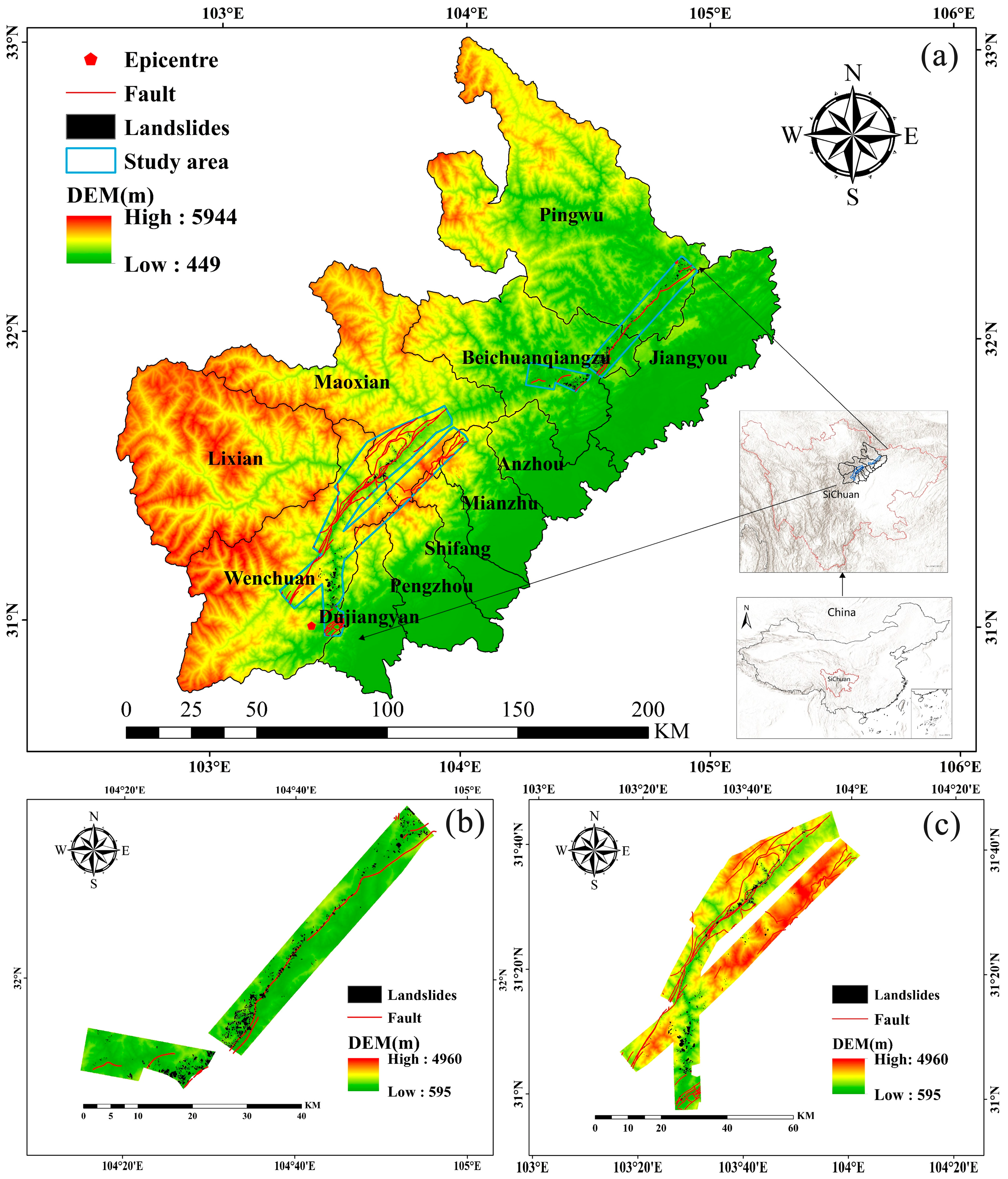

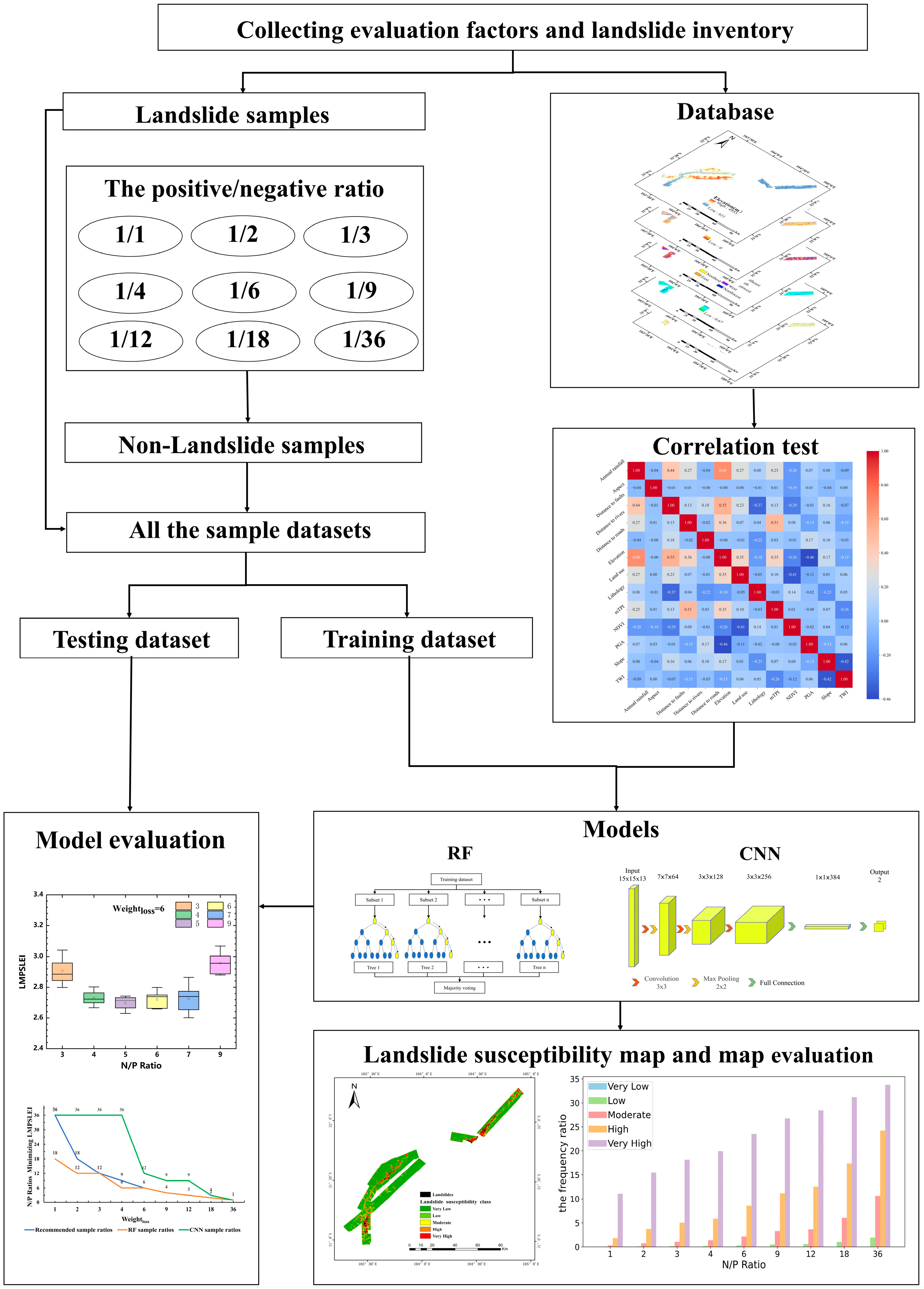

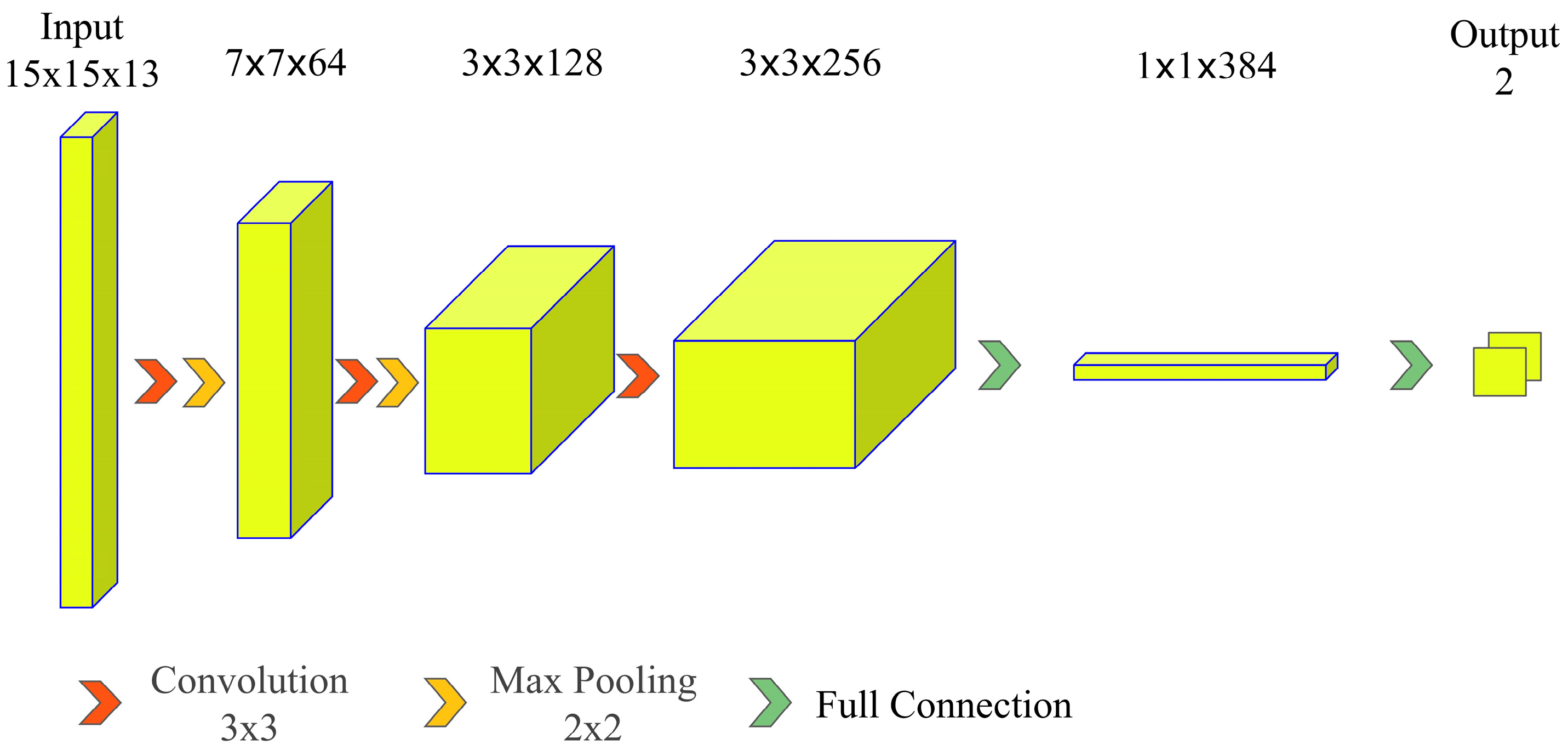

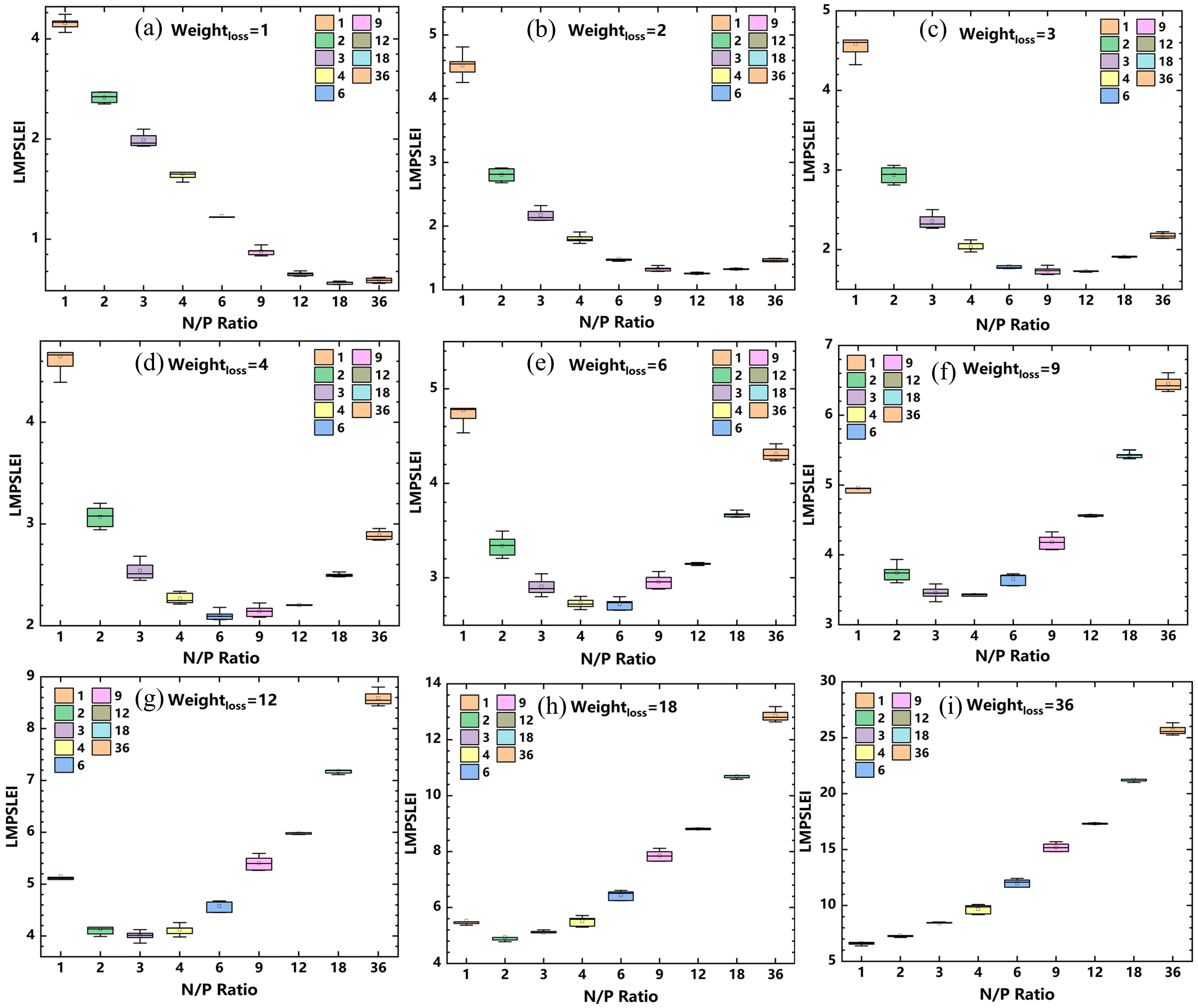
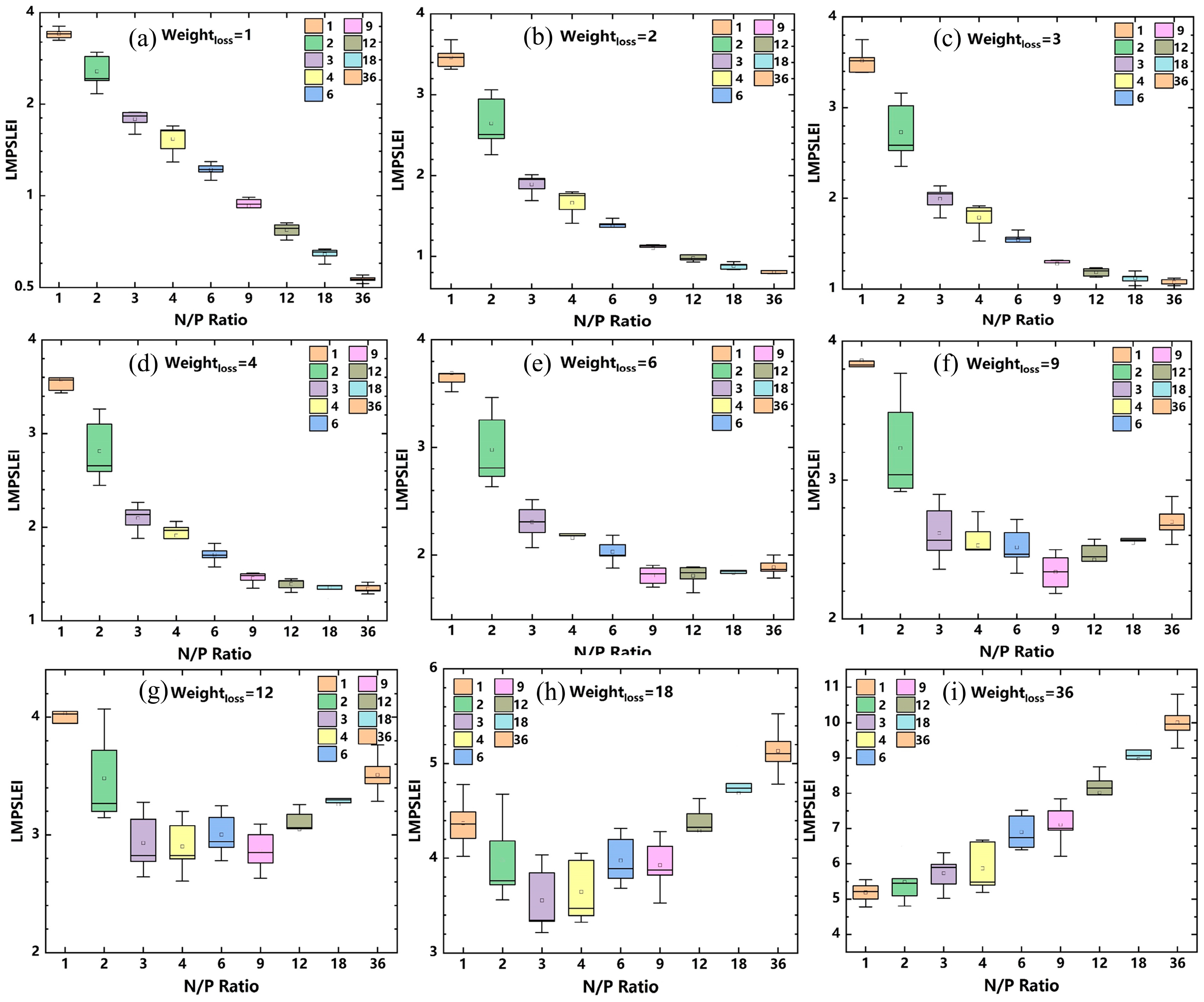

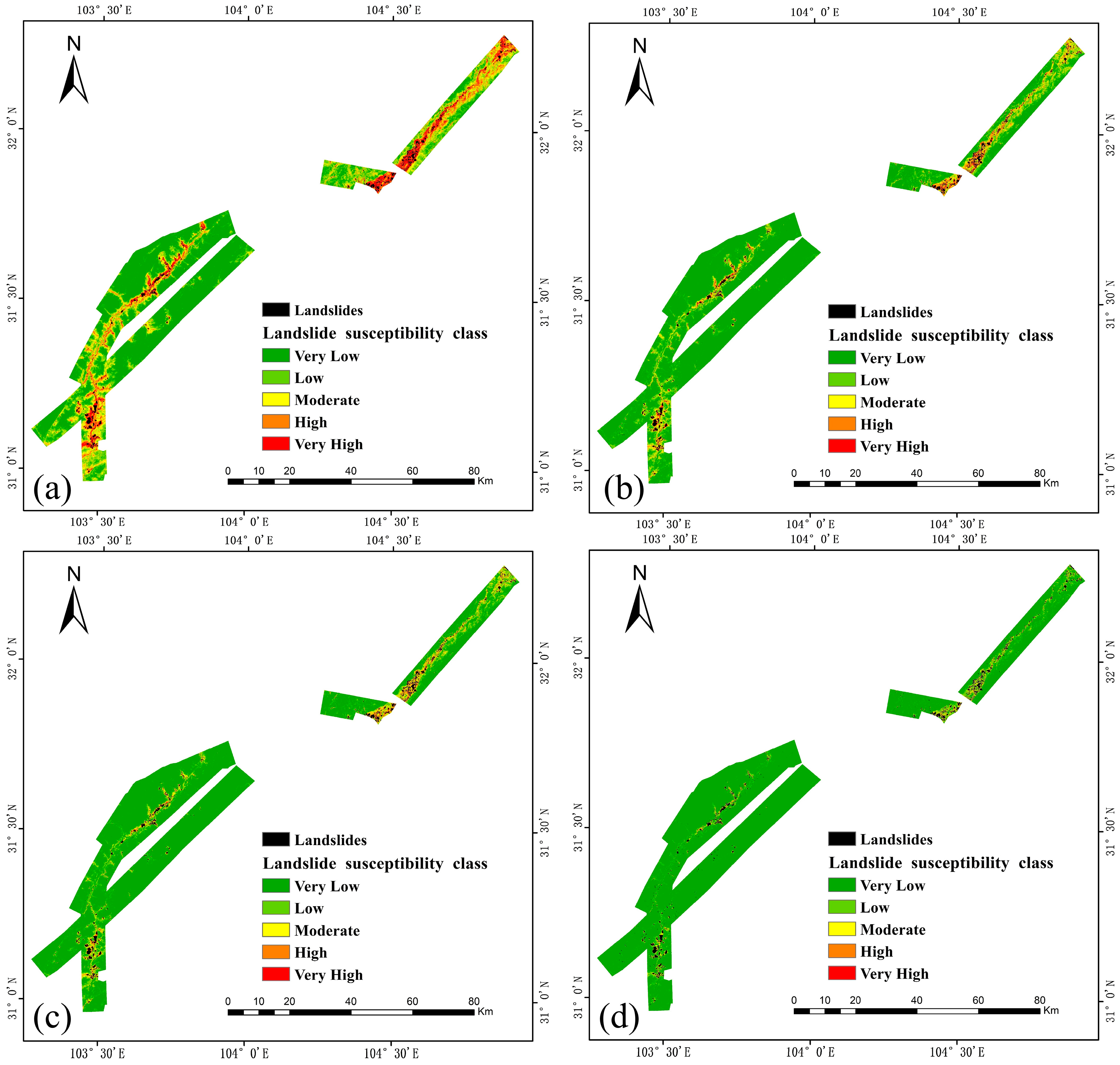




| Researchers | Landslide/Non-Landslide Sample Ratio | Non-Landslide Sampling Strategy |
|---|---|---|
| Tang et al. [19] | 1:1 | Repeatedly random sampling |
| Oh et al. [20] | Iterative random sampling | |
| Wang et al. [21] | Random sampling outside the buffer zone | |
| Zhu et al. [22] | Random sampling in areas of low susceptibility in rapid evaluation results | |
| Zhou et al. [23] | Random sampling in areas of low susceptibility in rapid evaluation results | |
| Shao et al. [27] | based on the ratio of landslide to non-landslide areas | Random sampling Random sampling |
| Xu et al. [28] | ||
| Pourghasemi et al. [29] | 1:2 | Random sampling |
| Sun et al. [30] | 1:10 | Random sampling |
| Lv et al. [31] | 1:1.2 | Random sampling outside the buff-er zone |
| Yang et al. [32] | 1:1.55 (SVM) 1:5 (RF) 1:6.16 (GBDT) | Random sampling outside the buff-er zone |
| Conditional Factors | Data Sources |
|---|---|
| Elevation | SRTM DEM (30 m) obtained from Google Earth Engine |
| Slope, Aspect, TWI | Calculated from DEM |
| mTPI | Global ALOS mTPI (270 m) obtained from Google Earth Engine |
| Lithology, Distance to faults | Extracted from the geological map with the scale 1:200,000 |
| NDVI | Landsat 5 TM image (30 m) |
| Annual rainfall | Global Resources Data Cloud (1 km) |
| Land use | China Land Cover Dataset (CLCD, 30 m) |
| Distance to roads, Distance to rivers | Obtained from the National Geomatics Center of China (NGCC) with the scale 1:200,000 |
| PGA | Obtained from USGS |
| N/P Ratio | RF Recall | CNN Recall | RF Specificity | CNN Specificity | RF Accuracy | CNN Accuracy | RF F1 Score | CNN F1 Score |
|---|---|---|---|---|---|---|---|---|
| 1 | 0.9372 | 0.9150 | 0.8779 | 0.8856 | 0.9075 | 0.9003 | 0.9102 | 0.9017 |
| 2 | 0.8661 | 0.8638 | 0.9296 | 0.9221 | 0.9084 | 0.9027 | 0.8631 | 0.8555 |
| 3 | 0.8169 | 0.8296 | 0.9498 | 0.9425 | 0.9166 | 0.9143 | 0.8304 | 0.8287 |
| 4 | 0.7687 | 0.8062 | 0.9627 | 0.9492 | 0.9239 | 0.9206 | 0.8016 | 0.8024 |
| 6 | 0.6905 | 0.7733 | 0.9760 | 0.9635 | 0.9352 | 0.9363 | 0.7528 | 0.7763 |
| 9 | 0.5921 | 0.7639 | 0.9858 | 0.9686 | 0.9465 | 0.9481 | 0.6885 | 0.7465 |
| 12 | 0.5278 | 0.7072 | 0.9913 | 0.9773 | 0.9557 | 0.9565 | 0.6467 | 0.7146 |
| 18 | 0.4138 | 0.6583 | 0.9958 | 0.9847 | 0.9651 | 0.9675 | 0.5552 | 0.6805 |
| 36 | 0.2877 | 0.6168 | 0.9989 | 0.9918 | 0.9797 | 0.9816 | 0.4332 | 0.6453 |
Disclaimer/Publisher’s Note: The statements, opinions and data contained in all publications are solely those of the individual author(s) and contributor(s) and not of MDPI and/or the editor(s). MDPI and/or the editor(s) disclaim responsibility for any injury to people or property resulting from any ideas, methods, instructions or products referred to in the content. |
© 2025 by the authors. Published by MDPI on behalf of the International Society for Photogrammetry and Remote Sensing. Licensee MDPI, Basel, Switzerland. This article is an open access article distributed under the terms and conditions of the Creative Commons Attribution (CC BY) license (https://creativecommons.org/licenses/by/4.0/).
Share and Cite
Lu, Z.; Chen, Y.; Wei, Y.; Zhang, Y.; Cheng, X. New Sampling Method for Landslide Susceptibility Evaluation with Consideration of Minimizing Potential Societal Losses. ISPRS Int. J. Geo-Inf. 2025, 14, 309. https://doi.org/10.3390/ijgi14080309
Lu Z, Chen Y, Wei Y, Zhang Y, Cheng X. New Sampling Method for Landslide Susceptibility Evaluation with Consideration of Minimizing Potential Societal Losses. ISPRS International Journal of Geo-Information. 2025; 14(8):309. https://doi.org/10.3390/ijgi14080309
Chicago/Turabian StyleLu, Zhao, Yu Chen, Yongming Wei, Yufei Zhang, and Xianfeng Cheng. 2025. "New Sampling Method for Landslide Susceptibility Evaluation with Consideration of Minimizing Potential Societal Losses" ISPRS International Journal of Geo-Information 14, no. 8: 309. https://doi.org/10.3390/ijgi14080309
APA StyleLu, Z., Chen, Y., Wei, Y., Zhang, Y., & Cheng, X. (2025). New Sampling Method for Landslide Susceptibility Evaluation with Consideration of Minimizing Potential Societal Losses. ISPRS International Journal of Geo-Information, 14(8), 309. https://doi.org/10.3390/ijgi14080309









